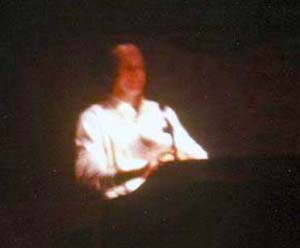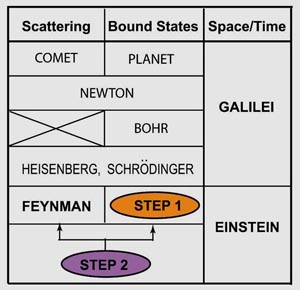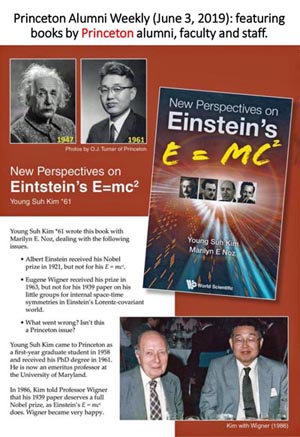Richard Phillip Feynman speaking at the
Spring Meeting of
the American Physical Society (Washington, DC, USA, 1970)
 |
|
- In 1970, the April meeting of the American Physical Society was held
at Washington's Shoreham Hotel. There was a Nobel session in which
five Nobel Laureates gave their talks. All were dressed neatly, except
Feynman. He was without coat and necktie as you can see from this
photo.
- What Feynman said in his lecture was also stunning. He was talking
about the use of harmonic oscillator wave functions for relativistic
quark model, and the content of his talk was published in
Phys. Rev. [Feynman, Kislinger, and Ravndal,
Phys. Rev. D 3 ,
2706 (1971)]. He told us not to use Feynman diagrams but use oscillator
wave functions for relativistic bound states.
I liked his talk very much and I was even excited, but most of my colleagues thought Feynman was absolutely crazy. Furthermore, it is generally agreed that the above-mentioned Phys. Rev. paper gets a failing grade from the mathematical point of view.
- In spite of all these, I am very proud to say that what Feynman said
at the 1970 meeting became the starting point of my research program.
This is perhaps the reason why many of my colleagues are saying I am
crazy. I started my program by making up the mathematical shortcomings
in his 1971 paper. Thanks to Eugene Wigner, I knew how to use the
Poincaré group, and started constructing normalizable covariant harmonic
oscillator wave functions. I started publishing papers on this subject
in 1973 with Marilyn Noz.
She has been and still is my most valuable co-author.
Those covariant wave functions can be Lorentz-boosted. Using these wave functions, I was able to show that the quark model and Feynman's parton picture were two different manifestations of one covariant entity. These oscillator wave functions later became the mathematical base for squeezed states of light.
Let us go back to 1970. Why was I so excited? Five years earlier, Freeman Dyson gave an invited talk at the same APS meeting. He made an important remark which led to the so-called "Dashen-Frautchi Fiasco." I published a paper about their work, and I was in political hot water for several years [the issue was that Dashen is a genius but Kim was something else]. Click here, if you are interested.

-
Click on the figure for a detailed story.
- During those difficult years, I came to the conclusion that the
present form of quantum field theory with Feynman diagrams cannot solve
the problem of bound-state problems with localized probability distribution,
as illustrated in this figure. I was a very lonely person in the physics world
where quantum field theory was thought to be the ultimate unification of
quantum mechanics and special relativity. Naturally, I was excited to hear
Feynman saying that we should try localized harmonic oscillator wave functions
for bound states instead of Feynman diagrams. In short, Feynman was telling
to complete
Step 1 given in the figure, and I did.
Indeed, R. P. Feynman was my savior.
- I am still working on Feynman's physics. You may click on my
Feynman Agenda
to see where the story stands these days.
Click here if you are interested in my Feynman page.
copyright@2021 by Y. S. Kim, unless otherwise specified.
|
- Click here for his home page.
- His photo-biography.
- His Princeton page.
- His Einstein page.
- His Style page.

I received my PhD degree from Princeton in 1961, seven years after
high school graduation in 1954. This means that I did much of the
ground work for the degree during my high school years.
